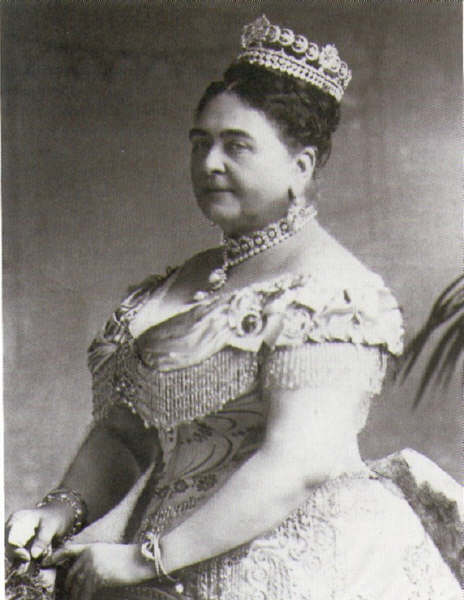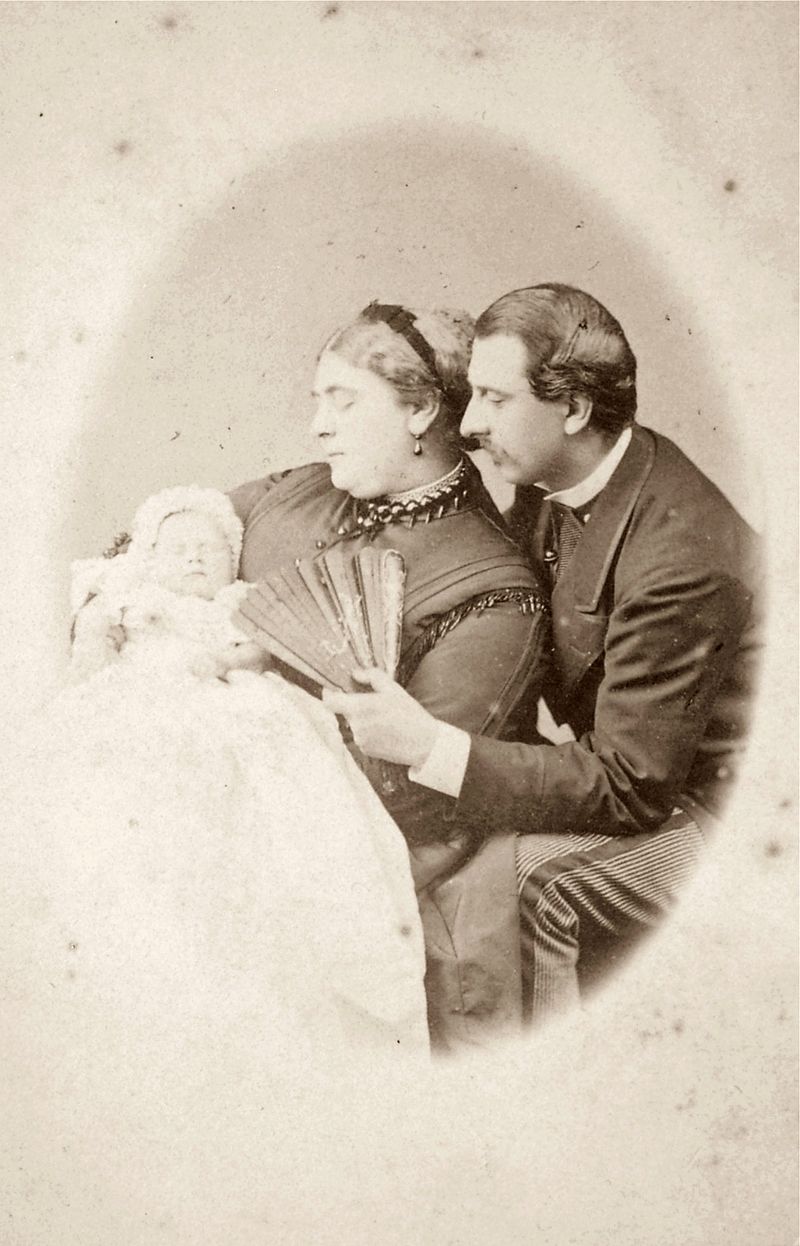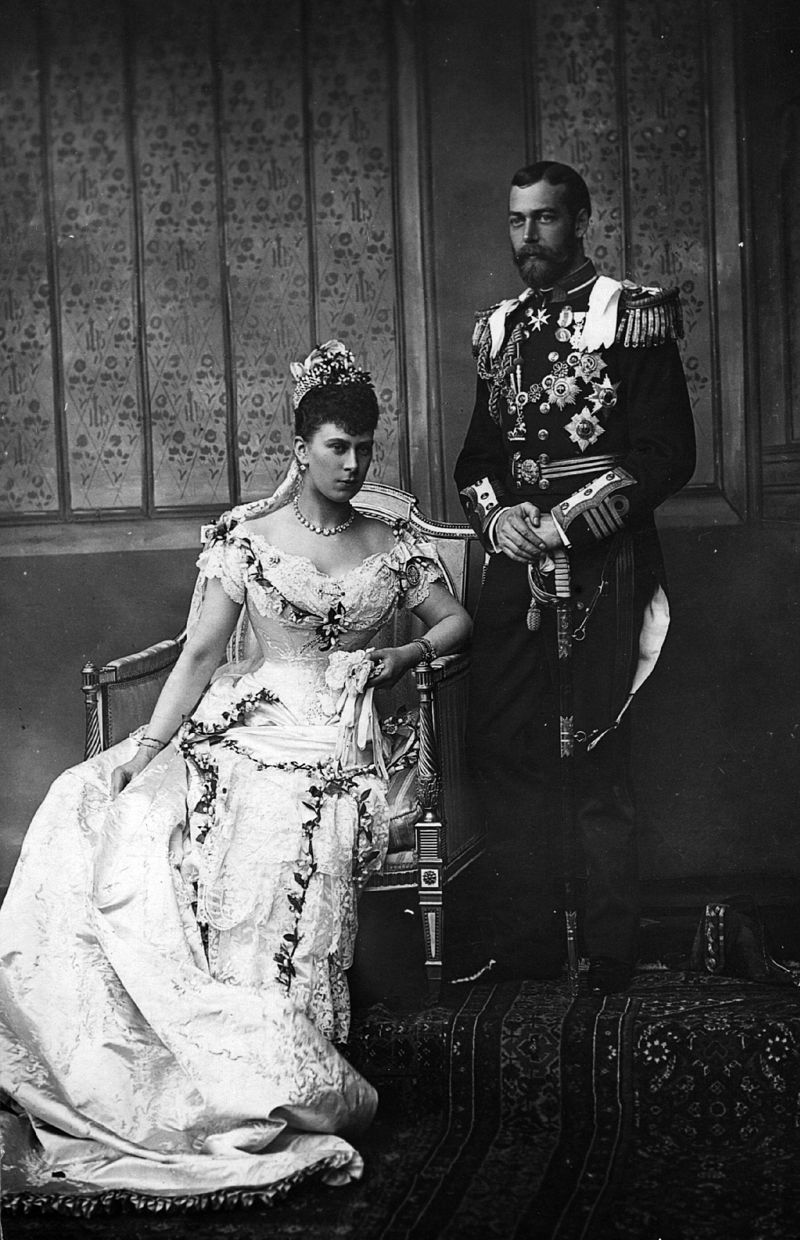by Susan Flantzer © Unofficial Royalty 2016

Princess Mary Adelaide of Cambridge, Duchess of Teck; Credit – Wikipedia
Princess Mary Adelaide of Cambridge was a male-line grandchild of King George III of the United Kingdom, a first cousin of Queen Victoria of the United Kingdom, and the mother of Mary of Teck, wife of King George V of the United Kingdom. Through her daughter Mary (known as May), Mary Adelaide is the great-grandmother of Queen Elizabeth II of the United Kingdom and an ancestor of the members of the House of Windsor. Princess Mary Adelaide, the youngest of the three children of Prince Adolphus, Duke of Cambridge (the seventh son and tenth child of King George III and Queen Charlotte) and Princess Augusta of Hesse-Kassel. She was born on November 27, 1833, at Cambridge House in the Kingdom of Hanover where her father served as Viceroy of Hanover for his brothers King George IV and King William IV, who were also Kings of Hanover.
The infant princess was christened on January 9, 1834, at Cambridge House in Hanover by Reverend John Ryle Wood, chaplain to her father. She was named Mary Adelaide Wilhelmina Elizabeth for her godparents. Her godparents were:
- King William IV (her paternal uncle)
- Queen Adelaide (her paternal aunt by marriage)
- Princess Mary, Duchess of Gloucester (her paternal aunt)
- Grand Duchess of Mecklenburg-Strelitz (born Princess Marie of Hesse-Kassel, her maternal aunt)
- Princess Elizabeth, Landgravine of Hesse-Homburg (her paternal aunt)
- Princess Friedrich Augustus of Anhalt-Dessau (born Princess Marie Luise of Hesse-Kassel, her maternal first cousin)
Mary Adelaide had an older brother and an older sister:
- Prince George, Duke of Cambridge (1819 – 1904), married Sarah Louisa Fairbrother, had issue (marriage was in contravention of the Royal Marriages Act so it was not legal and children of the marriage were illegitimate)
- Princess Augusta of Cambridge, Grand Duchess of Mecklenburg-Strelitz (1822 – 1916), married Friedrich Wilhelm, Grand Duke of Mecklenburg-Strelitz, had issue
Upon the accession of Queen Victoria in 1837, Mary Adelaide’s family returned to England. Because Hanover followed the Salic Law which allowed only male succession through the male line, Queen Victoria could not become Hanover’s monarch and the Kingdom of Hanover separated from the British crown. Queen Victoria’s eldest surviving paternal uncle, Prince Ernest Augustus, became King of Hanover, and he moved to his new kingdom.
In 1838, the Duke of Cambridge’s family made their permanent residence at Cambridge Cottage in Kew Gardens. It had been purchased from John Stuart, 3rd Earl of Bute who had helped Augusta of Saxe-Gotha, the Dowager Princess of Wales (mother of King George III) create Kew Gardens. In 1806, King George III settled the Cambridge Cottage on his youngest surviving son Adolphus Frederick, Duke of Cambridge. From 1839 – 1843, Cambridge Cottage was remodeled and extended to form the building it is today.
In 1850, Mary Adelaide’s father Prince Adolphus, Duke of Cambridge, died. By this time both Mary Adelaide’s siblings, who were much older, had married. The Duchess of Cambridge continued to live at Cambridge Cottage with Mary Adelaide. When the Duchess died in 1889, her son George, 2nd Duke of Cambridge, moved into the Cottage with his wife and lived there until his own death in 1904. He had no legitimate male heirs so the title Duke of Cambridge became extinct and King Edward VII presented Cambridge Cottage to Kew Gardens. Today Cambridge Cottage is used for weddings and other events.
In 1851, 17-year-old Mary Adelaide made her social debut at the official opening of the Great Exhibition which Queen Victoria’s husband, Prince Albert had helped organize. Soon the Duchess of Cambridge and Mary Adelaide were enjoying the social events in London. They also gave receptions and parties at Cambridge Cottage and lived a genial and happy existence in contrast to the more formal atmosphere of Buckingham Palace and Windsor Castle. For the next fifteen years, Mary Adelaide and her mother led a very active social life.

Princess Augusta Wilhelmina Louisa, Duchess of Cambridge; Princess Mary Adelaide, Duchess of Teck by Camille Silvy, albumen carte-de-visite, 9 October 1860 NPG Ax46799 © National Portrait Gallery, London
Princess Mary Adelaide weighed approximately 250 pounds and was affectionately known as “Fat Mary.” Her first cousin Queen Victoria wrote of her, “Her size is fearful. It is really a misfortune.” Because of her large size, many members of her family considered her unmarriageable. Mary Adelaide, however, was high-spirited and full of life and was adored by the Victorian public who called her “The People’s Princess.” After failed marriage prospects with Prince Oscar of Sweden (the future King Oscar II of Sweden) and others, a suitable candidate was eventually found in Württemberg, Prince Francis of Teck.
His Serene Highness Prince Francis of Teck was the product of a morganatic marriage. Prince Francis’ father, Duke Alexander of Württemberg, was once heir to the throne of Württemberg. However, Duke Alexander contracted a morganatic marriage (marriage to a person of a lower rank) to a Hungarian countess, Claudine Rhedey. Alexander lost his rights to the throne and his children lost the right to use the Württemberg name. Francis’ cousin King Karl of Württemberg eventually elevated him to the more important Germanic title of Duke of Teck. “Fat” Mary Adelaide (age 33) and genealogically-tainted Francis (age 29) married on June 12, 1866, at St. Anne’s Church in Kew in the London Borough of Richmond upon Thames.

Mary Adelaide and Francis with their first child, Princess Victoria Mary of Teck,; Credit – Wikipedia
The couple had four children:
- Princess Victoria Mary of Teck (1867 – 1953), married Prince George, Duke of York (later King George V), had issue
- Prince Adolphus of Teck, later Duke of Teck and Marquess of Cambridge (1868 – 1927), married Lady Margaret Grosvenor, daughter of Hugh Grosvenor, 1st Duke of Westminster, had issue
- Prince Francis of Teck (1870 – 1910), unmarried, no issue
- Prince Alexander of Teck, later Earl of Athlone (1874 – 1957), married Princess Alice of Albany, daughter of Prince Leopold, Duke of Albany, Queen Victoria’s hemophiliac son, had issue
During World War I in 1917, when British royals were anglicizing names and titles, Adolphus became the Marquess of Cambridge and Alexander became the Earl of Athlone. Both Adolphus and Alexander adopted the surname Cambridge.

Mary Adelaide with her children by Alexander Bassano, half-plate glass negative, circa 1884 NPG x96004 © National Portrait Gallery, London
Mary Adelaide and Francis had a happy marriage but had chronic financial problems due to Mary Adelaide’s extravagance and generosity. Queen Victoria gave them an apartment at Kensington Palace where their four children were born. In 1883, the Tecks fled from their creditors to the European continent where it was cheaper to live. The family lived with various relatives in Europe and eventually settled down in Florence, Italy. The Tecks returned from Italy in 1885 and continued to live at Kensington Palace and White Lodge in Richmond Park. Mary Adelaide devoted her life to charity, serving as the first royal patron of Barnardo’s, a charity still in existence, founded by Thomas Barnardo in 1866 to care for vulnerable children and young people. Barnardo’s has a long history of royal patrons and presidents including Queen Alexandra, Queen Mary (Mary Adelaide’s daughter), Queen Elizabeth II, Diana, Princess of Wales, and Queen Camilla.

Mary Adelaide, circa 1880; Credit – Wikipedia
Princess Mary Adelaide wanted her daughter May to marry one of the sons of The Prince of Wales (the future King Edward VII). Prince Albert Victor, known as Prince Eddy, was the Prince of Wales’ eldest son and therefore, second in the line of succession. Eddy was backward and lazy. He was an apathetic student and received very little education. He was primarily interested in pursuing pleasure which often led him into trouble. His lack of concentration on anything serious caused great concern in his family. Eddy’s family decided that finding a suitable wife might help correct his attitude and behavior. It was at this time that, unbeknownst to her, May was considered the most suitable bride for Eddy. Eddy offered no resistance to this suggestion. May had been brought up to revere the monarchy and to be proud that she was a member of the British Royal Family. The fact that May’s father was a product of a morganatic marriage could have presented difficulties for her in the marriage market. Despite Eddy’s shortcomings, May felt it was her duty to marry him. The engagement was announced on December 6, 1891, and the wedding was set for February 27, 1892.
Amid the wedding preparations, Eddy developed a high fever on January 7, 1892. Two days later, his lungs became inflamed and pneumonia was diagnosed. On the morning of January 14, 1892, Eddy died, surrounded by his parents, the Prince and Princess of Wales, his brother George, his sisters Louise, Victoria, and Maud, his fiancée May, and her mother the Duchess of Teck. Eddy’s funeral was held at St. George’s Chapel, Windsor where he is buried in the Albert Memorial Chapel. May’s wedding bouquet of orange blossoms lay on his coffin.
After the death of Prince Eddy, May and Eddy’s brother George, who replaced his brother as the second in the line of succession to the throne, spent much time together. As time passed and their common grief eased, there was hope that a marriage might take place between them. George proposed to May on April 29, 1893. The engagement was announced on May 3, 1893, with the blessing of Queen Victoria. May and George were married on July 6, 1893, at the Chapel Royal, St. James’ Palace in London.

George and May on their wedding day; Credit – Wikipedia
Mary Adelaide’s dream was fulfilled. Her only daughter would one day be Queen of the United Kingdom. After the marriage of her daughter, Mary Adelaide’s health declined. She dreadfully missed May. Queen Victoria wrote: “What Mary will do without May, I cannot think, for she is her right hand.” Mary Adelaide lived long enough to see May’s first three children: the future King Edward VIII, the future King George VI, and the future Mary, Princess Royal. She was a godmother of the future King Edward VIII and the future Mary, Princess Royal.
By the summer of 1896, Mary Adelaide’s health was worsening. In April 1897, she had a serious emergency operation, but she made a quick recovery that allowed her to participate in Queen Victoria’s Diamond Jubilee celebration on June 22, 1897. On October 25, 1897, May noted in her diary, “Mama was not quite well.” The next day, the doctors decided that another emergency operation was necessary. Two hours after the operation was completed, Mary Adelaide died from heart failure at the age of 63. Mary Adelaide was buried in the Royal Vault at St. George’s Chapel, Windsor. Her husband Francis, Duke of Teck died on January 20, 1900, and was buried with his wife.

Mary Adelaide, Duchess of Teck, 3 July 1897; Credit – Wikipedia
This article is the intellectual property of Unofficial Royalty and is NOT TO BE COPIED, EDITED, OR POSTED IN ANY FORM ON ANOTHER WEBSITE under any circumstances. It is permissible to use a link that directs to Unofficial Royalty.
Works Cited
2016, Barnardo’s. Barnardos links between Barnardo’s children charity and royalty. 2016. Web. 17 Aug. 2016.
Pope-Hennessy, James. Queen Mary. New York: Alfred A. Knopf, 1960. Print.
“Princess Mary Adelaide of Cambridge.” Wikipedia. N.p.: Wikimedia Foundation, 28 June 2016. Web. 17 Aug. 2016.
Unofficial Royalty. Wedding of George V and Princess May of Teck. Unofficial Royalty, 16 Aug. 2016. Web. 17 Aug. 2016.
Williamson, David. Brewer’s British Royalty. London: Cassell, 1996. Print.

